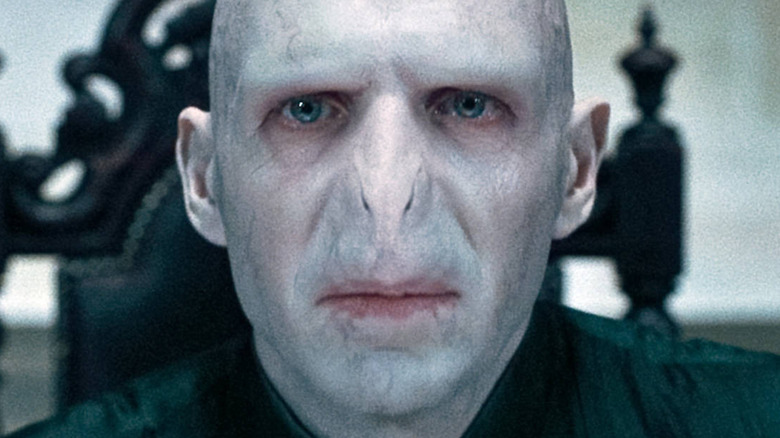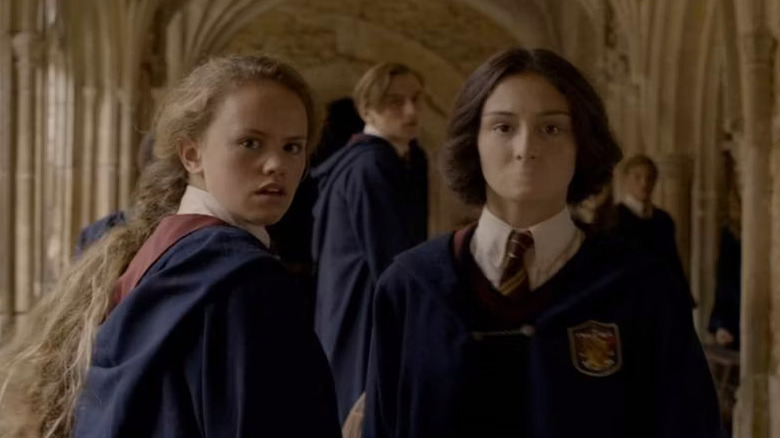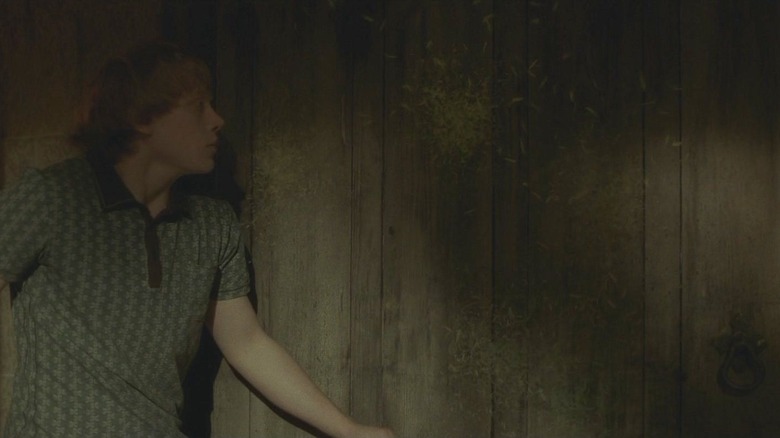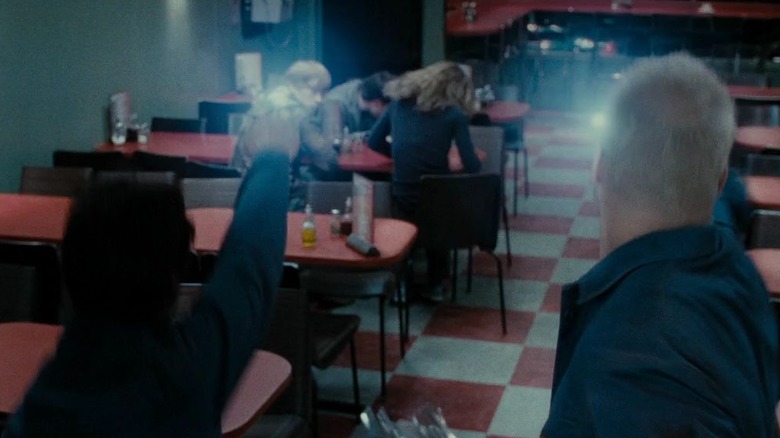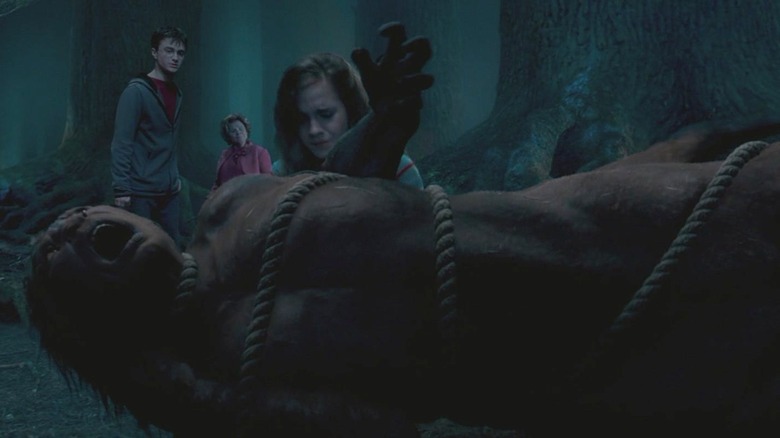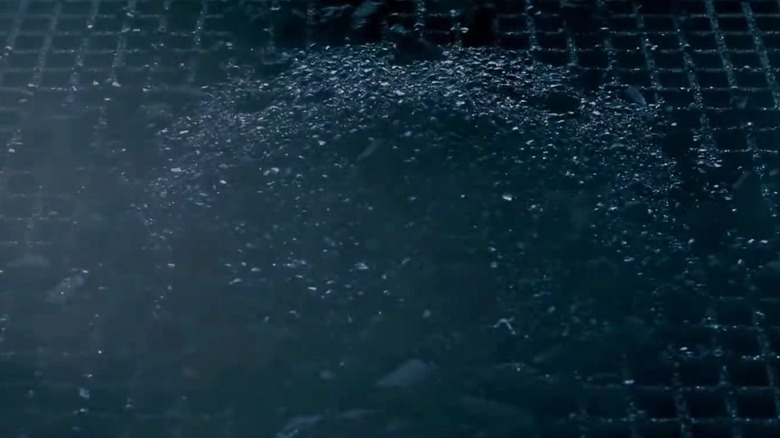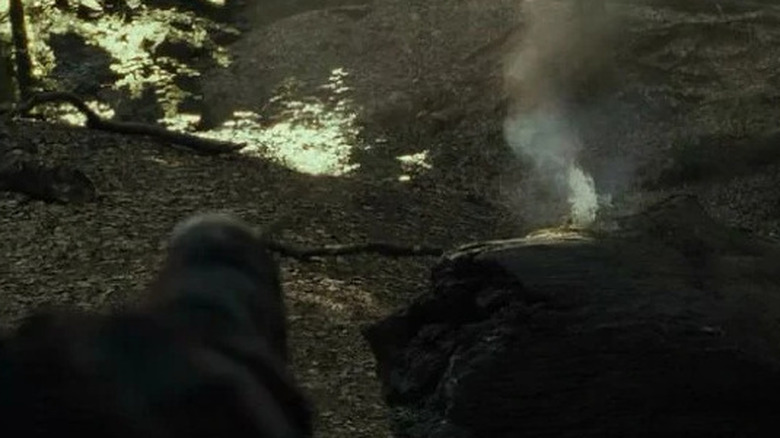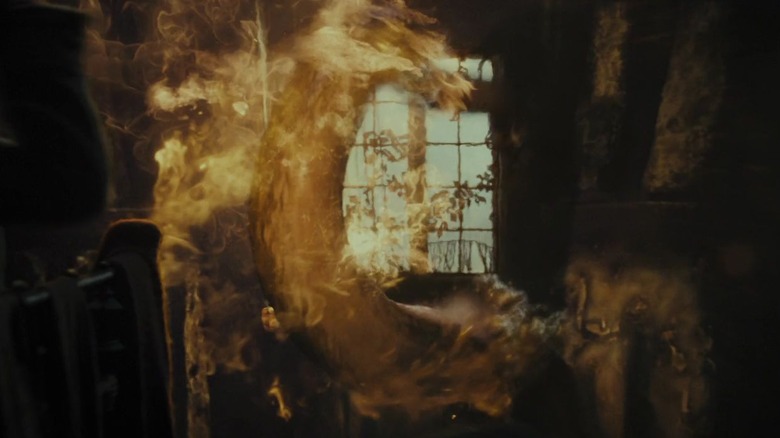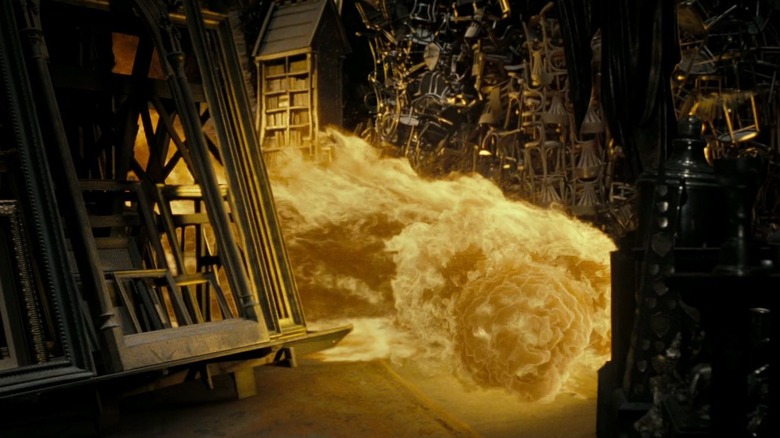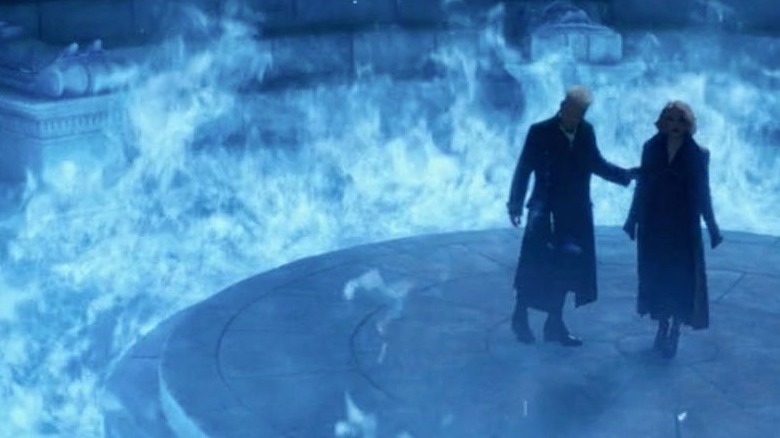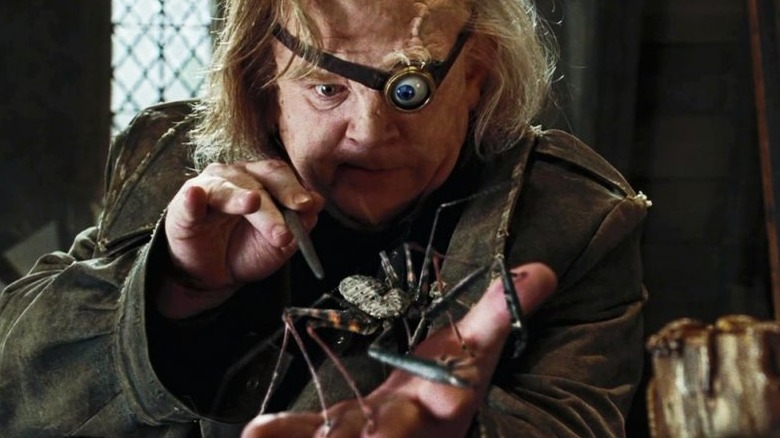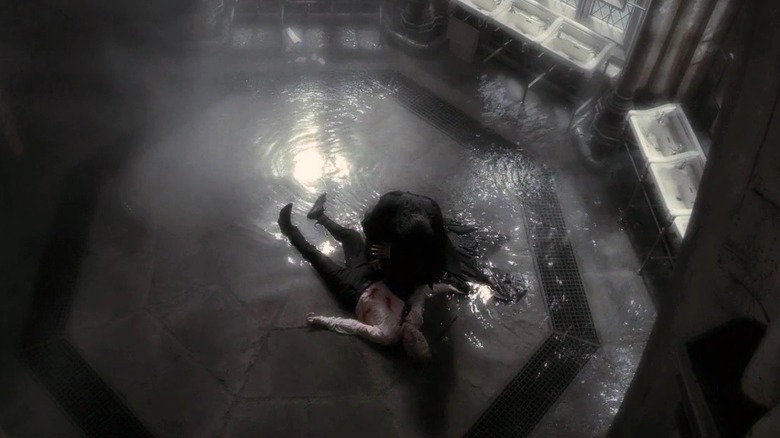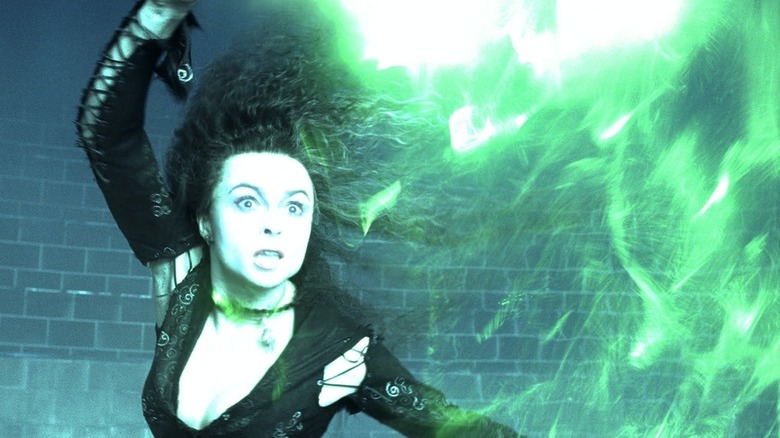12 Deadliest Spells In The Harry Potter Universe
"Harry Potter" took the world by storm upon its release in the late '90s. The popular book series spawned a movie franchise (which is still ongoing via the "Fantastic Beasts" films), a stage play, several video games, and all manner of merchandise, meaning The Boy Who Lived has entered pretty much every part of popular culture. Fans followed along eagerly as Harry learned he was a wizard from the half-giant Hagrid and stuck with him as he fought against Lord Voldemort, the evil wizard who tried to kill him when he was a baby. The full timeline of events goes back to the tenth century, and many of the spells we're going to look at in this list are just as old.
There's a staggering variety of spells, charms, hexes, jinxes, and curses in "Harry Potter" canon, some of which you will want to steer clear of at all cost. Not every spell produces a beautiful animal like Expecto Patronum or can give you light whenever you need it like Lumos. Some — like the one that may immediately come to mind — can even cause instant death. Of course, Avada Kedavra isn't the only curse that's deadly. Secure your wand and be ready to cast the Shield Charm as we go over the deadliest "Harry Potter" spells.
Oscausi
Let's start with a less obvious one. Oscausi is the incantation for an unnamed spell that seals the target's mouth shut. Skin grows over it, making it look like the mouth never existed at all. A young Leta Lestrange, fiancée of Newt Scamander's brother Theseus, used it during her third year at Hogwarts, as shown in "Fantastic Beasts: The Crimes of Grindelwald." A Gryffindor student in her year was making unkind remarks about the Slytherin behind her back, saying that she stays at Hogwarts over the holidays because her family didn't want her to come home.
Professor Minerva McGonagall, the Transfiguration professor, performs the spell to reveal the student's mouth again, but after they start to rant about Leta, she seems to reinstate Leta's enchantment, deeming it better that they remain quiet for the moment. If someone doesn't reverse the spell, the target would be unable to eat or drink. This could cause a slow and painful death as the person becomes hungry and thirsty but has no way to nourish themselves.
Oppugno
Fans of the sixth book, "Harry Potter and the Half-Blood Prince," will likely recall Oppugno. Hermione uses the spell to send a flock of birds after Ron after getting jealous about his blossoming (and unbearably sweet) relationship with Lavender Brown, a fellow Gryffindor. The jinx can send other objects, not just birds, towards a target, like when Harry uses it in "Harry Potter and the Deathly Hallows – Part 1" to send papers towards the Death Eater Yaxley as he tries to escape the Ministry of Magic. Those papers happened to be leaflets from The Daily Prophet, the popular British wizarding newspaper, emblazoned with Harry's wanted poster.
In theory, someone could easily use this spell to send something a bit more sinister flying toward their target. Sure, the leaflets could cause paper cuts and the birds could do some pecking, but those aren't exactly life-threatening. Think of items that could cause harm, like knives and other sharp objects. Because the spell hinges on the caster and their direction, it could be used to scare someone or fatally injure them. This may not be as quick to kill as other spells on this list, meaning if someone chooses to murder a person with this jinx they don't want it to be an easy end.
Expulso
Expulso is the incantation for a spell that blows up its target. It's used against Harry in "Harry Potter and the Deathly Hallows," after the trio escape Bill and Fleur's ill-fated wedding. At this point in the series, Lord Voldemort has taken over the Ministry of Magic, which means Harry, Ron, and Hermione are wanted fugitives. Two Death Eaters, Thorfinn Rowle and Antonin Dolohov, find them in a café as they are busy trying to decide their next move following a hasty exit.
During the ensuing fight, Rowle uses Expulso on a table, which bursts into pieces and blasts Harry into a wall. Imagine the damage Expulso would have when directed at a person. This curse could force someone into a wall or other hard surface with so much force that it causes a deadly injury — or just result in them being blown apart. Harry is left relatively uninjured after experiencing the spell secondhand, but that's because the table took the brunt of it.
Incarcerous
This spell is used to bind the target with ropes that are conjured from nothing. Professor Dolores Umbridge uses the spell to bind Magorian, a centaur that resides in the Forbidden Forest, when Harry and Hermione lure her there in "Harry Potter and the Order of the Phoenix." Hermione claims she is showing the Defense Against the Dark Arts professor a secret weapon they were told to make by Albus Dumbledore, but she's actually hoping the half-human, half-horse creatures will take care of the witch for them.
When the centaurs show up, Umbridge uses the spell against them, convinced they are trying to attack her and that she needs to defend herself. The ropes wrap around the centaur's torso, arms, and (in the film version, at least) even his throat. If the caster decides, they could strangle someone using this spell, depending on how tight they make the ropes. Incarcerous Spell is definitely deadly in the wrong hands.
Reducto
Reducto, also known as the Reductor Curse, is another spell that causes explosions, but don't confuse it with Expulso — the two blasts cause very different outcomes. While Expulso blasts an object apart, Reducto disintegrates the target into dust or mist, likely with heat. Harry uses it to make a hole in the hedge maze, the third task of the Triwizard Tournament in "Harry Potter and the Goblet of Fire," when he hears Cedric yelling at someone (later revealed to be Viktor Krum of Durmstrang). "It wasn't very effective," the book says about the spell. "But it burned a small hole in the hedge."
The full ability of the curse is revealed one school year later in "Harry Potter and the Order of the Phoenix." Parvati Patil, a Gryffindor in Harry's year, uses it to turn a table into dust (it's Ginny Weasley who perfects the spell in the film). This wasn't random: Parvati has been practicing the spell as part of her Dumbledore's Army training. This organization is designed for students that want to learn how to fight against Death Eaters (and maybe even Lord Voldemort himself), so it makes sense that she perfected the spell.
If the Reductor Curse was used on a person, there's a chance that they would end up like that table. And this isn't the Marvel Cinematic Universe — people don't come back after being turned to dust.
Diffindo
The Severing Charm (which has the incantation Diffindo), has been seen to cause physical harm, even if that wasn't the caster's intention. It's introduced in the series when Harry uses it to make Cedric Diggory's bag split open in "Harry Potter and the Goblet of Fire," and Ron utilizes it during the same year to spruce up his dress robes for the Yule Ball. It's pretty tame stuff, but later on, readers find out just how dangerous the spell can be.
When Rowle and Dolohov attack Harry, Ron, and Hermione at the café on Tottenham Court Road (changed to Shaftesbury Avenue in the movie), the brightest witch of her age uses Diffindo to free Ron from some ropes. But, because her hand is shaking, she accidentally makes a "deep cut" on his knee. If Hermione accidentally cut Ron using the Severing Charm just because she didn't have a steady hand, imagine what someone with malicious intentions could do with it.
It is important to note that Diffindo can be used on a human without ill effects, as Hermione uses the charm to remove Salazar Slytherin's locket (one of Lord Voldemort's Horcruxes) from Harry's chest after the incident in Godric's Hollow. There's a red mark left behind, but that's from the locket itself rather than the spell.
Confringo
There is one final explosion-related spell on our list. Confringo, or the Blasting Curse, causes the target of the spell to blast apart. It is similar to Expulso, but tends to have a wider impact area. Hermione uses it in "Harry Potter and the Deathly Hallows" during a confrontation with Nagini, Lord Voldemort's serpent-turned-Horcrux. The snake uses the body of famous wizarding historian Bathilda Bagshot, the author of "Hogwarts: A History," to lure them into her home with the intention of killing them. Hermione's spell blasts Nagini down the stairs, but it doesn't kill her.
Like other spells on this list, if it is used the right way it can certainly cause death — or be the reason someone is killed. When Harry uses it at the beginning of "Harry Potter and the Deathly Hallows" while sitting in a motorcycle sidecar, two Death Eaters near the blast seem to perish, falling from the sky. Rather than being used directly on a person, it can be used on objects near that person, which may result in a fatal injury due to the nature of the spell.
Fiendfyre
Fiendfyre is essentially cursed fire. It is incredibly dangerous because it consumes anything and everything in its path and is difficult to control. As it burns, magical creatures like serpents and birds sprout from it, and the fiery creations go after any individuals in the area. It is one of the few ways to destroy a Horcrux, but it definitely isn't as safe as using a basilisk fang or the Sword of Gryffindor. The incantation is unknown, but it's unlikely you'll stumble across it by mistake: This is magic taught by and for dark wizards.
In the book version of "Harry Potter and the Deathly Hallows," Vincent Crabbe uses Fiendfyre in the Room of Requirement (it's Gregory Goyle in the movie). "Like it hot, scum?" he shouts after setting the blaze that would ultimately claim his life. He was taught about Fiendfyre by Death Eater-turned-Hogwarts professor Amycus Carrow, but he never learned how to stop it. It's an awful way to go: These flames are so hot that Aguamenti — the Water-Making Spell — has zero effect on them.
Protego Diabolica
Protego Diabolica is a spell that creates a shield of fire around the caster. However, unlike the Shield Charm, Protego Diabolica is deadly. In "Fantastic Beasts: The Crimes of Grindelwald," Gellert Grindelwald uses this charm not only to protect himself from the Aurors trying to capture him in Paris, but to see which of his followers are completely devoted to his cause. Several of his followers, like Vinda Rosier and Credence Barebone, easily pass through the blue flames, as they are entirely devoted to their master. Others, like Queenie Goldstein, who have been convinced of Grindelwald's mission at this moment, walk through unharmed because their allegiance has shifted.
However, not everyone is as lucky. A follower named Krall is killed when he tries to pass through the wall of fire because, deep down, he's not completely devoted to Grindelwald's cause. The fire can also be manipulated and directed, almost like Fiendfyre. Grindelwald uses it on the Aurors trying to escape the area, claiming they are "cheating" by running away. He sends the flames chasing after them, and when they catch up, the Aurors are incinerated. Protego Diabolica is definitely among the deadliest spells in the "Harry Potter" universe.
Imperio
The Imperius Curse is one of three Unforgivable Curses. Using the incantation Imperio, the caster can take over the mind of another individual. This means they can make them do anything they want. A powerful victim can and will attempt to fight back, but it is difficult and not always successful. During the graveyard scene at the end of "Harry Potter and the Goblet of Fire," Lord Voldemort uses the curse on Harry several times — he fights back and eventually breaks free. But what about people who aren't as strong as Harry?
Imperio is used throughout the series for evil purposes. Draco uses it on Madam Rosmerta as part of his attempt to deliver a cursed necklace to Dumbledore in "Harry Potter and the Half-Blood Prince," and members of the Ministry of Magic are put under the spell by Voldemort and his followers. While the curse is not designed to be deadly, having full control over a person means bumping them off is easy.
When Alastor "Mad-Eye" Moody, serving as Defense Against the Dark Arts professor during Harry's fourth year, shows the class how Imperio works with a spider, they all laugh as the arachnid is forced to tap dance. "I could make it jump out of the window, drown itself, throw itself down one of your throats," he goes on to explain, changing the mood. Here, Moody (who turns out to be Barty Crouch Jr. in disguise) confirms that you can make someone take their life using the Imperius Curse, which is why it's so high on this list.
Sectumsempra
This spell isn't well-known among wizards, but those familiar with it know what it's capable of. Sectumsempra was created by Severus Snape during his youth. He wrote it down in his copy of the Potions textbook "Advanced Potion Making" along with the phrase, "for enemies." Harry "was itching to try it out" after he discovered it in "Harry Potter and the Half-Blood Prince," but he didn't feel it was wise to do so in front of Hermione.
Harry gets his chance when, later on in the book, he finds Draco Malfoy crying in the bathroom. He already suspects the youngest Malfoy has become an official Death Eater, and Harry finds the behavior suspicious. Harry isn't wrong about Draco: He took the Dark Mark and was instructed to kill Dumbledore, which he is struggling with. He realizes Harry is behind him and the two begin a duel, with Draco about to cast an Unforgivable Curse in Harry's direction. He's cut off when Harry uses Sectumsempra.
The effects are immediate. Draco collapses to the floor, blood pouring from his chest. Thankfully, Professor Snape appears and is able to use the countercurse to save Draco's life. Without help, he would have surely bled to death, which makes this spell very dangerous indeed. With the correct intent, the spell can cause less damage (as seen when a young Snape uses it to cut James Potter's cheek), but it's deadly in a fight.
Avada Kedavra
This wouldn't be a list of the deadliest spells in the "Harry Potter" universe if we didn't include the Killing Curse. The most notorious of the three Unforgivable Curses, you can't protect yourself from it and you can't remedy its effects after it has been cast. The incantation Avada Kedavra and the green flash of the spell are known and feared by everyone in the wizarding world. Harry survived nearly unmarked only because of his mother's love when the Dark Lord tried to kill him as a baby. The spell resulted in Lord Voldemort making Harry a Horcrux, quite unintentionally.
The Killing Curse is used a lot throughout the series, perhaps most memorably against Albus Dumbledore. Several people have dodged it, like Hermione during the Battle at the Department of Mysteries and Harry's son Albus Severus, who has the Killing Curse fired at him in "Harry Potter and the Cursed Child." It is the sixth most-used spell in the books, and the most used spell out of the ones included on this list. With no way to revive someone hit with it, the Killing Curse is by far the deadliest spell in the "Harry Potter" universe and well worthy of its status as an Unforgivable Curse.
